
Leg before wicket (lbw) is one of the ways in which a batter can be dismissed in the sport of cricket. Following an appeal by the fielding side, the umpire may rule a batter out lbw if the ball would have struck the wicket but was instead intercepted by any part of the batsman's body. The umpire's decision will depend on a number of criteria, including where the ball pitched, whether the ball hit in line with the wickets, the ball's expected future trajectory after hitting the batsman, and whether the batsman was attempting to hit the ball.

In baseball, the pitcher is the player who throws ("pitches") the baseball from the pitcher's mound toward the catcher to begin each play, with the goal of retiring a batter, who attempts to either make contact with the pitched ball or draw a walk. In the numbering system used to record defensive plays, the pitcher is assigned the number 1. The pitcher is often considered the most important player on the defensive side of the game, and as such is situated at the right end of the defensive spectrum. There are many different types of pitchers, such as the starting pitcher, relief pitcher, middle reliever, lefty specialist, setup man, and the closer.
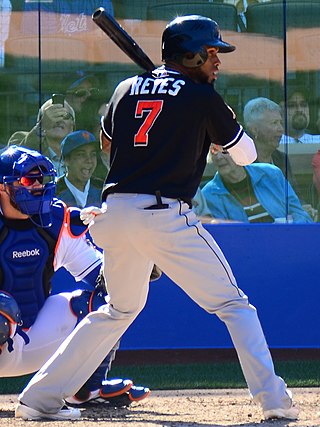
In baseball, a switch hitter is a player who bats both right-handed and left-handed, usually right-handed against left-handed pitchers and left-handed against right-handed pitchers, although there are some exceptions.

This is a general glossary of the terminology used in the sport of cricket. Where words in a sentence are also defined elsewhere in this article, they appear in italics. Certain aspects of cricket terminology are explained in more detail in cricket statistics and the naming of fielding positions is explained at fielding (cricket).
A cricket bat is a specialised piece of equipment used by batters in the sport of cricket to hit the ball, typically consisting of a cane handle attached to a flat-fronted willow-wood blade. It may also be used by a batter who is making batter's ground to avoid a run out, by holding the bat and touching the ground with it. The length of the bat may be no more than 38 inches and the width no more than 4.25 inches. Its use is first mentioned in 1624. Since 1979, a law change has dictated that cricket bats can only be made from wood.
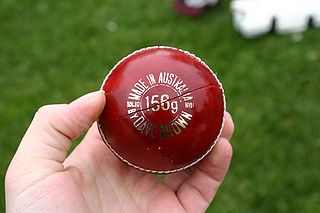
A cricket ball is a hard, solid ball used to play cricket. A cricket ball consists of a cork core wound with string then a leather cover stitched on, and manufacture is regulated by cricket law at first-class level. The trajectory of a cricket ball when bowled, through movement in the air, and off the ground, is influenced by the action of the bowler and the condition of the ball and the pitch, while working on the cricket ball to obtain optimal condition is a key role of the fielding side. The principal method through which the batter scores runs is by hitting the ball, with the bat, into a position where it would be safe to take a run, or by directing the ball through or over the boundary. Cricket balls are harder and heavier than baseballs.
Short form cricket is a collective term for several modified forms of the sport of cricket, with playing times significantly shorter than more traditional forms of the game.

In cricket, the boundary is the perimeter of a playing field. It is also the term given to a scoring shot where the ball is hit to, or beyond, that perimeter, which generally earns four or six runs for the batting team.
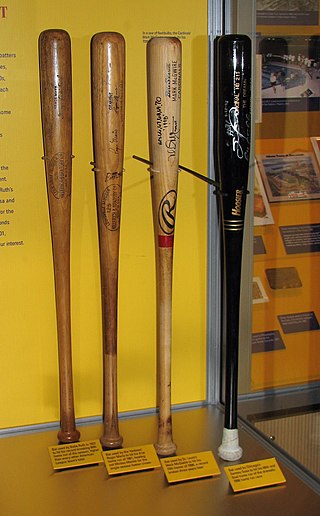
A baseball bat is a smooth wooden or metal club used in the sport of baseball to hit the ball after it is thrown by the pitcher. By regulation it may be no more than 2.75 inches (7.0 cm) in diameter at the thickest part and no more than 42 inches (1.067 m) in length. Although historically bats approaching 3 pounds (1.4 kg) were swung, today bats of 33 ounces (0.94 kg) are common, topping out at 34 to 36 ounces.

In baseball, the batting order or batting lineup is the sequence in which the members of the offense take their turns in batting against the pitcher. The batting order is the main component of a team's offensive strategy. In Major League Baseball, the batting order is set by the manager, who before the game begins must present the home plate umpire with two copies of his team's lineup card, a card on which a team's starting batting order is recorded. The home plate umpire keeps one copy of the lineup card of each team, and gives the second copy to the opposing manager. Once the home plate umpire gives the lineup cards to the opposing managers, the batting lineup is final and a manager can make changes only under the Official Baseball Rules governing substitutions. If a team bats out of order, it is a violation of baseball's rules and subject to penalty.

In baseball, batting is the act of facing the opposing pitcher and trying to produce offense for one's team. A batter or hitter is a person whose turn it is to face the pitcher. The three main goals of batters are to become a baserunner, to drive runners home or to advance runners along the bases for others to drive home, but the techniques and strategies they use to do so vary. Hitting uses a motion that is virtually unique to baseball and its fellow bat-and-ball sports, one that is rarely used in other sports. Hitting is unique because it involves rotating in the horizontal plane of movement, unlike most sports movements which occur in the vertical plane.

Brännboll, known as rundbold in Denmark, Brennball in Germany, and sharing the names slåball and brentball with longball in Norway, is a bat-and-ball game similar to longball, played at amateur level throughout Sweden, Finland, Norway, Denmark and Germany. The game is mostly played on fields, sports grounds, and in public parks, but it is also part of the PE curriculum in some areas. The name is derived from the act of catching a player between two bases at the end of a batting round, referred to as "burning" them (bränna), roughly equivalent to being run out in cricket or out in baseball. The world championship, called Brännbollscupen, is an annual event in the Swedish city of Umeå.
Danish longball is a bat-and-ball game similar to brännboll played in Denmark, Sweden and Norway. It is also played in some British secondary schools, notably Manor School and Sports College, and is played recreationally by scouts, the Air Training Corps, Wetheringsett Camp Suffolk, and by the Royal Navy and Australian Navy. It is also played at some U.S. summer camps.

Hot Spot is an infrared imaging system used in cricket to determine whether the ball has struck the batsman, bat or pad. Hot Spot requires two infrared cameras on opposite sides of the ground above the field of play that are continuously recording an image. Any suspected nick or bat/pad event can be verified by examining the infrared image, which usually shows a bright spot where contact friction from the ball has elevated the local temperature. Where referrals to an off-field third umpire are permitted, the technology is used to enhance the on-field umpire's decision-making accuracy. Where referrals are not permitted, the technology is used primarily as an analytical aid for television coverage.

Cricket is a bat-and-ball game that is played between two teams of eleven players on a field at the centre of which is a 22-yard (20-metre) pitch with a wicket at each end, each comprising two bails balanced on three stumps. Two players from the batting team stand in front of either wicket, with one player from the fielding team bowling the ball towards the striker's wicket from the opposite end of the pitch. The striker's goal is to hit the bowled ball and then switch places with the nonstriker, with the batting team scoring one run for each exchange. Runs are also scored when the ball reaches or crosses the boundary of the field or when the ball is bowled illegally.
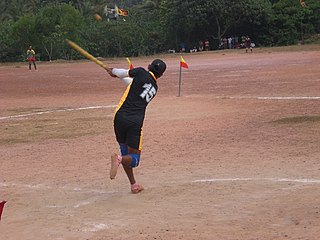
Elle is a popular bat-and-ball game in Sri Lanka which is also a localised name for slow-pitch softball, often played in rural villages and urban areas. From modern-day sports popular around the world, Elle has the most similarities with softball. The game is played between two teams and the play scenario involves a hitter, a pitcher and fielders. The hitter is given three chances to hit the ball pitched at him or her. Once the hitter hits the ball with the bat – often a sturdy bamboo stick – the hitter has to complete a round or run which includes four possible "stoppings" spaced 55 metres (180 ft) apart. A strikeout happens if the hitter's ball is caught by the fielding side or if the fielding side is able to hit the hitter with the ball while he or she is in the course of completing a run. The hitter can stop only at one of the three stoppings in the round thereby paving the way for another member of his team to come and become the hitter. The side that gets the highest number of (complete) runs wins the match.

The game of indoor cricket can be played in any suitably sized multi-purpose sports hall. There is evidence of the game being played in the 1920s and 1930s. Furthermore, it was played in the 1960s as a means of giving amateur and professional cricketers a means of playing their sport during the winter months. The first recorded organised indoor cricket league in the world took place in 1970 in North Shropshire, and the first national tournament was completed in 1976 with over 400 clubs taking part. By 1979 over 1000 clubs were taking part in indoor cricket in the UK, and it remains extremely popular today with many leagues around the country. Other forms of indoor cricket have been developed, based on variations of the indoor game.
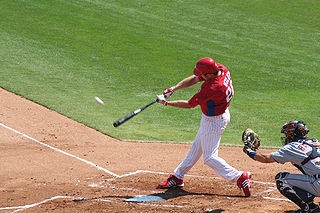
In baseball, hitting mechanics studies the biomechanical motion that governs the swing of a baseball player. The goal of biomechanics in hitting during baseball training is to study and improve upon the physics involved in hitting. This includes optimizing a player's swing for either maximizing their "bat speed" or time for plate coverage. There is a wide range of batting stances and mechanics that are developed through individual preferences. However, when comparing among experienced baseball players, their batting mechanics approach are almost similar.

Ryan John "Rowdy" Tellez is an American professional baseball first baseman for the Pittsburgh Pirates of Major League Baseball (MLB). He has previously played in MLB for the Toronto Blue Jays and Milwaukee Brewers. He has played for the Mexico national baseball team.
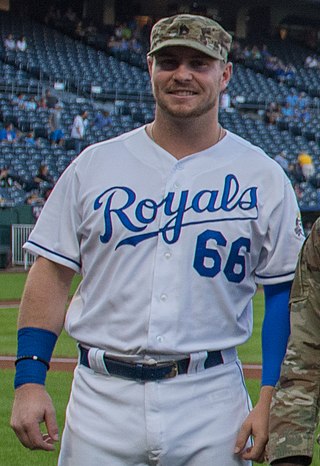
Ryan Patrick O'Hearn is an American professional baseball first baseman for the Baltimore Orioles of Major League Baseball (MLB). He has previously played in MLB for the Kansas City Royals.
















